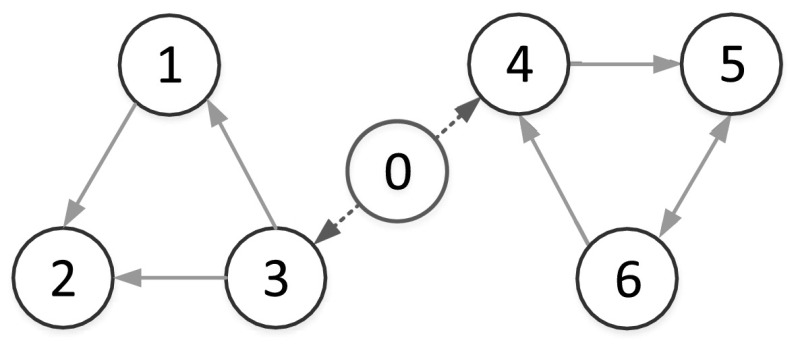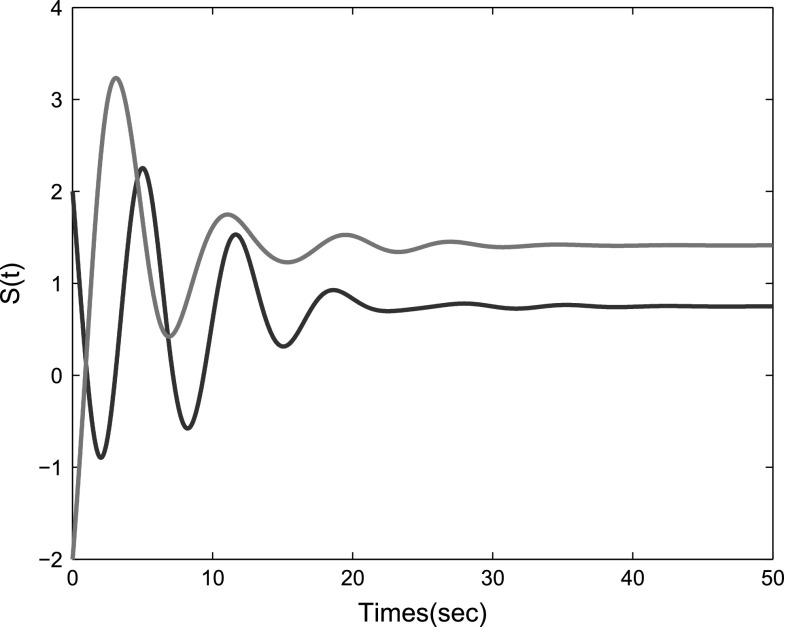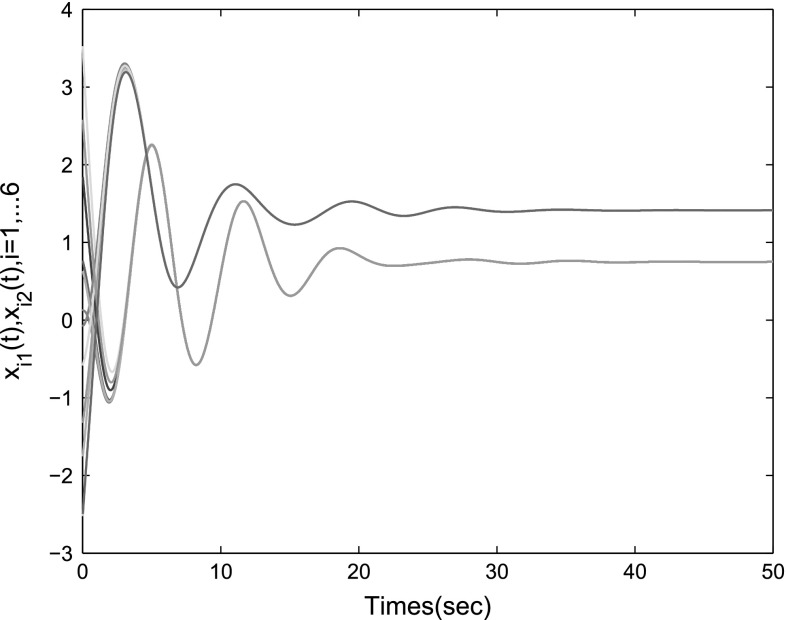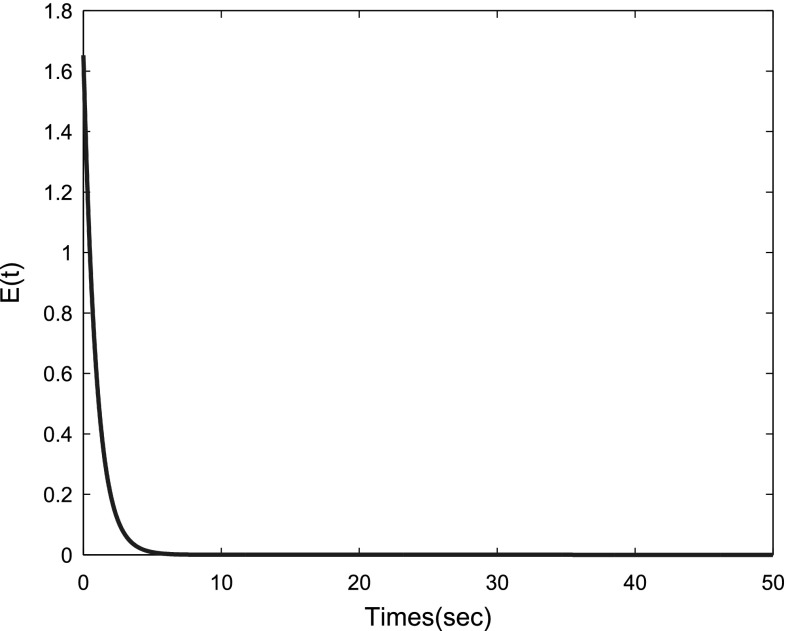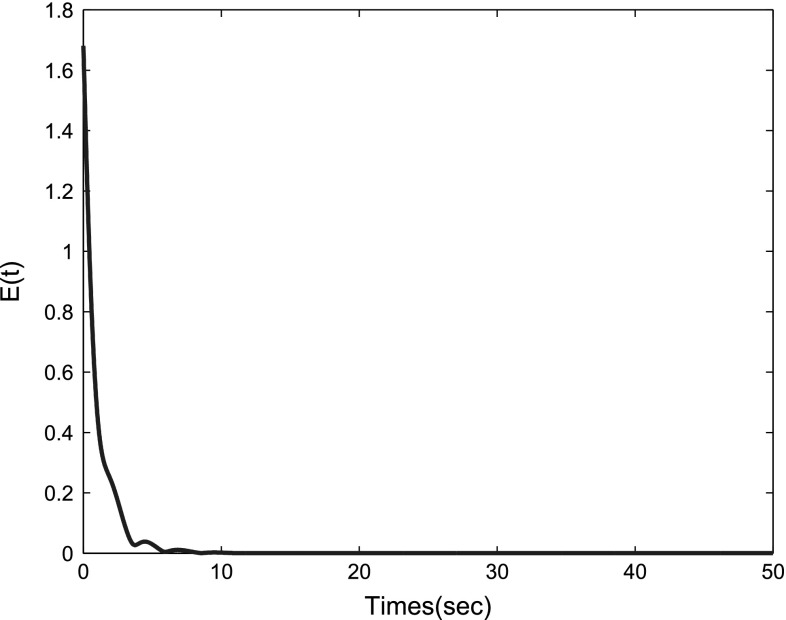Abstract
The paper is devoted to the investigation of synchronization for an array of linearly and diffusively coupled inertial delayed neural networks (DNNs). By placing feedback control on a small fraction of network nodes, the entire coupled DNNs can be synchronized to a common objective trajectory asymptotically. Two different analysis methods, including matrix measure strategy and Lyapunov–Krasovskii function approach, are employed to provide sufficient criteria for the synchronization control problem. Comparisons of these two techniques are given at the end of the paper. Finally, an illustrative example is provided to show the effectiveness of the obtained theoretical results.
Keywords: Inertial delayed neural networks, Pinning synchronization, Matrix measure, Lyapunov–Krasovskii function
Introduction
Complex dynamical networks (CDNs), which are coupled by a large collection of dynamic nodes, can emerge some captivating phenomena, such as synchronization, consensus, swarming, flocking and rendezvous. Synchronization of CDNs is always the central topic among these collective behaviors which has received much attention in the past decade (Yu et al. 2013; Jeong et al. 2013; Shen and Cao 2011; Hu et al. 2014). In literature, numerous synchronization patterns have been introduced and studied, such as complete synchronization, local synchronization, generalized synchronization, projective synchronization, partial synchronization, lag synchronization and cluster synchronization. We are interested in the global complete synchronization in this paper. On the other hand, for general CDNs, due to the existence of weak coupling or disconnected communication in the network, synchronization phenomena cannot be achieved autonomously most of the time. And therefore, to reach a global synchronization, some extra controllers need to be designed and imposed on nodes of the network. Recently, pinning control has become a popular choice for synchronization control of CDNs (Wang and Chen 2002; Chen et al. 2007) since such a scheme can greatly reduce the cost of control by controlling only a small fraction of the nodes instead of all the nodes in the network.
As for neural networks, most of the previous publications mainly concentrated on stability analysis and periodic or almost periodic attractors for different kinds of neural networks with or without time delays (Forti and Tesi 1995; Arik 2000; Hu et al. 2013). While authors in Chen et al. (2004) investigated the global synchronization of linearly and diffusively coupled identical delayed neural networks (DNNs) by Lyapunov functional methods and Hermitian matrix theory. Synchronization of coupled neural networks means multiple neural networks can achieve a common trajectory, such as a common equilibrium, limit cycle or chaotic trajectory. Based on Lyapunov functional method and linear matrix inequalities (LMIs), exponential synchronization was studied in Lu and Chen (2004) for coupled connected neural networks with delays. Drive–response synchronization of neural networks with or without time-varying delay was considered in Cao and Lu (2006) based on adaptive feedback control method. By introducing the delayed coupling term, the global exponential synchronization was discussed in Cao et al. (2006) for an array of DNNs with constant and delayed couplings. Furthermore, the hybrid coupling case was considered in Cao et al. (2008), where constant, discrete and distributed-delay couplings coexist. Sufficient conditions were derived for local synchronization of coupled DNNs with discontinuous activation functions (Liu and Cao 2011). Based on sampled-data control, synchronization of neural networks with time-varying delays was investigated in Wu et al. (2012). Drive–response exponential synchronization was formulated in Yang et al. (2014) for a class of neural networks with mixed delays and discontinuous activations. Synchronization for coupled memristive neural networks with time-varying delays was considered recently (Zhang et al. 2013; Wen et al. 2013; Wang et al. 2014). For more studies concerning synchronization of neural networks, see Wu and Park (2013), Yang et al. (2014), Fang and Park (2013) and references cited therein.
In literature, neural network models are always described by first-order differential equations; while inertial electronic neural networks, which are modeled by second-order differential equations, were introduced in Babcock and Westervelt (1987) with small scale number of neurons, such as one-or two-neuron models. It was found that when the neuron coupling was of an inertial nature, the dynamics can be more complex compared with the simpler behavior displayed in standard resistor-capacitor variety. Furthermore, some local stability and Hopf/Bogdanov–Takens bifurcation problems of a single delayed neuron model with inertial terms were investigated in Li et al. (2004), Liu et al. (2009), He et al. (2012). Most of the published investigations concerning the inertial neural networks are always focusing on small-scale neural networks with only one or two neurons with/without time delays, and the general inertial neural network coupled by multiple neurons is rarely seen. Recently, the authors in Ke and Miao (2013) considered the stability and existence of periodic solutions for inertial bidirectional associative memory (BAM) neural networks with time delays. Furthermore, stability analysis was carried out in Ke and Miao (2013) for inertial Cohen–Grossberg-type neural networks with time delays. While in Cao and Wan (2014), the stability of an inertial DNN was investigated by matrix measure strategies and drive–response synchronization was considered as an application at the end of the paper.
Pinning synchronization of coupled neural networks is another interesting research area, which has received much attention. Such as, based on adaptive pinning control, the synchronization problems were investigated in Zhou et al. (2008), Song et al. (2012) for a general weighted neural network with coupling delay. Cluster synchronization problem was studied in Li and Cao (2011) for an array of coupled stochastic delayed neural networks by using pinning control strategy. By pinning impulsive control, exponential synchronization was considered in Yang et al. (2013) for an array of linearly and diffusively coupled reaction-diffusion neural networks with time-varying delays. Robust synchronization problem for the coupled neural networks with mixed delays and uncertain parameters was investigated in Zheng and Cao (2014) by intermittent pinning control. For more studies concerning pinning synchronization of neural networks, we refer to Lu et al. (2009), Wang et al. (2013), Shi et al. (2014) and references cited therein.
Motivated by the above discussions, this paper is intended to investigate the synchronization of coupled inertial delayed neural networks by pinning control. To the best of our knowledge, there are very few studies on the synchronization problem of the coupled inertial DNNs. We shall investigate the pinning synchronization (i.e., leader-following synchronization) for an array of linearly and diffusively coupled inertial delayed neural networks by matrix measure strategy and Lyapunov functional method, respectively. Matrix measure technique has been widely utilized to deal with synchronization problem for complex networks (Sun and Zhang 2004; Chen 2006; Juang and Liang 2009) and neural networks (He and Cao 2009; Cao and Wan 2014). It has been shown that the matrix measure approach has several advantages, such as without needing to construct Lyapunov function or functional, making full use of matrix elements’ information and simple stability criteria (Cao and Wan 2014). We will provide several sufficient synchronization criteria for the coupled inertial DNNs in terms of matrix measure and LMIs. Furthermore, we conclude that the matrix measure may not be appropriate to deal with synchronization of large-scale coupled network with high-dimensional node. The main contributions of this article are listed as follows: (1) leader-following synchronization of inertial neural networks is considered; (2) pinning feedback control is introduced to synchronize the coupled inertial DNNs to the objective trajectory; (3) two different kinds of synchronization criteria are provided by matrix measure and Lyapunov functional methods, respectively.
The rest of this paper is structured as follows. In “Model description and preliminaries” section, model description and some preliminaries are briefly outlined. In “Main results” section, main theorems are given for the synchronization of the coupled inertial DNNs by pinning control. Illustrative example is provided in “Illustrative example” section to demonstrate the utility of the theoretical results. Finally, conclusions are drawn in “Conclusions” section.
Model description and preliminaries
Notation
Throughout this paper, and denote the -dimensional Euclidean space and the set of all real matrices, respectively. denotes the identity matrix and is the diagonal matrix with diagonal entries –. Matrix is called Hurwitz if all the eigenvalues of lie in the open left half-plane. The notation , where and are symmetric matrices, means that the matrix is positive definite, while denotes is a positive semidefinite matrix. Matrices, if their dimensions are not explicitly stated, are assumed to be compatible for the algebraic operations.
Consider an array of linearly coupled inertial DNNs consisting of identical nodes with the dynamics of the node described by the following equation:
| 1 |
where is the state vector of the neural network and are constant positive definite matrices. and denote the connection weight matrix and the delayed connection weight matrix, respectively. The nonlinear function is the activation function for the inertial neural network; is the external input vector. The second derivative of is called an inertial term of system (1). The positive constant is the network coupling strength and is the inner coupling matrix; is the constant coupling configuration matrix defined to be diffusive: and . The coupling matrix is not required to be symmetric or irreducible.
The initial conditions associated with system (1) are given as , , where denotes the set of all -dimensional continuous differentiable functions defined on the interval with .
To proceed, the following assumptions, definitions and lemmas are given.
Assumption 1
The activation function is bounded and satisfies Lipschitz condition, i.e., there exist constants and such that
hold for all .
Assumption 2
The time delay in (1) is a bounded and differentiable function of time satisfying for all , where .
Remark 1
The above Assumption 1 is used to ensure the existence and uniqueness of the solution of inertial DNNs (2) with Lipschitzian activation functions without assuming their monotonicity or differentiability (Cao and Wan 2014).
Definition 1
The coupled inertial neural network (1) is said to be globally asymptotically synchronizable to the goal trajectory if the following discriminant relations
hold for all initial functions.
Definition 2
For a matrix , the matrix measure is defined as follows:
where is an induced matrix norm on with . The corresponding matrix norms and measures are given as follows,
| Matrix norm | Matrix measure |
|---|---|
where are any constant numbers.
Remark 2
Note that the -matrix measure was introduced in Cao (2004), which is the generalization of the -matrix measure . On the other hand, a simple interpretation for matrix measure is that the measure is the derivative of the norm of at . It is easy to see that if , then is “instantaneously norm-contractive” and, consequently, Hurwitz stable (Bolzern et al. 2006).
Lemma 1
(Halanay 1966) Letbe a continuous function such that
is satisfied for. If, then
where, andis the unique positive real root of the equation.
Lemma 2
(Horn and Johnson 2012) For a nonsingular matrix, the following statements are equivalent:
is a nonsingular Minkovski matrix (M-matrix).
The off-diagonal elements of matrixsatisfyandexists with each entry ofis nonnegative.
is a positive stable matrix (all eigenvalues of matrixhave positive real parts, i.e.,for all).
There exists a diagonal matrixsuch that.
Main results
In this section, we investigate the global synchronization of the coupled inertial DNNs by pinning control, which means that the feedback injections are only placed on a small fraction of total network nodes and most of network nodes are not directly controlled. The isolated node of network (1) is given by the following inertial delayed DNN:
| 2 |
where . The initial condition for system (2) is given as .
The pinning controlled network is given as follows:
| 3 |
where ; and if the node is pinned, otherwise .
By letting the synchronization error , one can derive the following error system:
| 4 |
where .
Next, by introducing the following variable transformation:
the error system (4) can be written as
| 5 |
for , where and ; is the Laplacian matrix of the coupling network.
By letting and , together with the Kronecker product, the error system (5) can be written as the following compact forms:
| 6 |
where is the pinning matrix and .
The coupled inertial DNNs (3) can be synchronized if the error system (6) is globally asymptotically stable. In the following, two different analysis methods, including matrix measure strategy and Lyapunov–Krasovskii function approach, are employed to provide sufficient criteria for the globally asymptotically stable of the error system (6).
Matrix measure method
In this section, we utilize the matrix measure strategy to derive the stability conditions for the error system. By defining , the augmented error system can be obtained:
| 7 |
where and the coefficient matrices are
Theorem 1
Under Assumptions 1 and 2, if there exists a kind of matrix measure such that
| 8 |
where is the maximal lipschitz constant, then the pinning controlled coupled inertial DNNs (3) is globally exponentially synchronization.
Proof
According to the error system (7), the upper-right Dini derivative of with respect to along the solution of (7) is as follows:
By inequality (8) and Lemma 1, one can derive
where is the unique positive real root of the equation .
Therefore, converges exponentially to zero with a convergence rate , that is, the globally synchronization is achieved. This completes the proof.
Noting that the synchronization condition (8) in Theorem 1 is based on the maximal lipschitz constant . The following Theorem 2 gives a more detailed synchronization criterion which utilizes the information of each lipschitz constant . To derive the main result, the following lemma is needed, stated as follows,
Lemma 3
(He and Cao 2009) Under Assumption 1, let be the corresponding matrix measure associated with the induced matrix norm on. Then, where,,, and
Theorem 2
Under Assumptions 1 and 2, if there exists a matrix measure such that
| 9 |
where , , then the pinning controlled coupled inertial DNNs (3) is globally exponentially synchronization.
Proof
Under a simple transformation, the error system (6) is equivalent to the error system (10):
| 10 |
where with , and .
The upper-right Dini derivative of with respect to along the solution of (10) is as follows:
If the inequality holds, then by Lemma 1, one can derive
where is the unique positive real root of the equation .
Therefore, converges exponentially to zero with a convergence rate , that is, the globally synchronization is achieved. This completes the proof.
Lyapunov–Krasovskii method
In the pinning controlled coupled network (3), a pinned node can access objective information of the isolated node (2). That is, there is a directed link from the isolated node to the pinned node. If the objective trajectory is labeled as the dynamic of the node 0, then a new network appears. We use the union of the network and the node (i.e., ) to denote the pinning joint communication topology (Hu et al. (2014)). The Laplacian matrix of is
in which and is the pinning matrix. Before proposing the main results, we need the following lemma.
Lemma 4
(Song et al. 2012) The matrix is a nonsingular-matrix if and only if the pinning joint communication topology has a directed spanning tree.
Based on the pinning control, if the pinning joint communication topology has a directed spanning tree, then matrix is a nonsingular -matrix. By Lemma 2, there exists a positive diagonal matrix such that .
Theorem 3
Under Assumptions 1 and 2, and the pinning joint communication topology has a directed spanning tree, then the coupled inertial neural network (1) is globally asymptotically synchronization if there exists a positive definite matrix such that
| 11 |
where is a positive constant and ; and .
Proof
To prove the result, one just need to show that the error system (6) is globally asymptotically stable. Consider the following Lyapunov–Krasovskii functional candidate for system (6)
| 12 |
Calculating the time derivative of along the trajectories of system (6), one can obtain
It follows from Assumption 1 that
| 13 |
and
| 14 |
Combining inequalities (13) and (14), we have
where . Thus, by LMI (11), we have for , which indicates that and . Therefore, the pinning controlled network (3) can be globally asymptotically synchronized to the objective trajectory.
Remark 3
In fact, in order to make , the matrix needs to satisfy . Furthermore, if , then indicates that is necessary. On the other hand, by checking the negative definite of , one can derive the lower bound for the coupling strength .
Illustrative example
In this section, one illustrative example is presented to demonstrate the effectiveness of the obtained theoretical results. Consider the following coupling inertial DNNs with six nodes:
| 15 |
where , , and the time delay . So it is easy to get , and . The inner coupling matrix in (15) is given with and the coefficient matrices are given as
The coupling matrix is determined by the directed topology given in Fig. 1 with . Let the initial state of the objective system be on the interval and initial functions for system (15) are chosen randomly. We use the quantity to measure the quality of the synchronization process. By setting the pinning node set (see Fig. 1). The objective trajectory of the pinning controlled system (1) is shown in Fig. 2.
Fig. 1.
The coupling communication topology
Fig. 2.
Objective state trajectory in system (2)
By checking the inequality (8) in Theorem 1, it is easy to compute when and , , and , which follows that . Based on the conclusion in Theorem 1, the coupled inertial DNNs can be exponentially synchronized. The synchronization state trajectories and synchronization error are given in Figs. 3 and 4.
Fig. 3.
State trajectories in system (15)
Fig. 4.
Synchronization error
Under the pinning node set , one can derive that . By setting and the coupling strength , it is easy to check the LMI (11) in Theorem 3 has a positive definite solution, which ensures that the whole coupled neural network system (15) can be synchronized to the given goal trajectory asymptotically. The state trajectories and the synchronization error of (15) are given in Figs. 5 and 6.
Fig. 5.
State trajectories in system (15)
Fig. 6.
Synchronization error
Remark 4
Matrix measure strategy is an efficient tool to address the stability problem of nonlinear systems. Usually, the established results by using matrix measure are more general than common algebraic criterion due to the fact that matrix measure can be not only taken positive value but also negative value. However, in the synchronization problem for the coupled network, the augmented coefficient matrices of the close-loop controlled system are always high-dimension sparse matrices, which make the verification of the corresponding matrix measure become difficult. On the contrary, the derived condition in the form of LMIs may be more easier to be satisfied with a relatively small coupling strength.
Remark 5
It is difficult to check the inequality (9) in Theorem 2 for under the parameter settings in this example. From the verification conditions in Theorems 1 and 3, one can find that Lyapunov functional method is better than the matrix measure strategy in terms of easy verification for the established criteria when dealing with coupled networks, which suggests that matrix measure strategies are not always better than the classical Lyapunov functional methods.
Conclusions
In this paper, the synchronization control problem has been investigated for coupled inertial DNNs by pinning feedback control. Firstly, matrix measure strategies are utilized to analyze the close-loop error system, under which two sufficient criteria have been established such that the exponential synchronization can be achieved. Furthermore, based on the Lyapunov–Krasovskii method, another sufficient condition has been derived for the asymptotically synchronization for the coupled inertial DNNs. It has been shown that the Lyapunov functional method is more appropriate to deal with the synchronization problem for large-scale coupled CDNs compared with matrix measure strategy.
Acknowledgments
This work was jointly supported by the National Natural Science Foundation of China under Grants 61272530; the Natural Science Foundation of Jiangsu Province of China under Grant BK2012741; the Specialized Research Fund for the Doctoral Program of Higher Education under Grant 20130092110017; the “Fundamental Research Funds for the Central Universities”, the JSPS Innovation Program under Grant KYLX, and the Scientific Research Foundation of Graduate School of Southeast University YBJJ1448.
References
- Arik S. Stability analysis of delayed neural networks. IEEE Trans Circuits Syst I Fundam Theory Appl. 2000;47(7):1089–1092. doi: 10.1109/81.855465. [DOI] [Google Scholar]
- Babcock KL, Westervelt RM. Dynamics of simple electronic neural networks. Phys D. 1987;28(3):305–316. doi: 10.1016/0167-2789(87)90021-2. [DOI] [Google Scholar]
- Bolzern P, Colaneri P, De Nicolao G. On almost sure stability of continuous-time markov jump linear systems. Automatica. 2006;42(6):983–988. doi: 10.1016/j.automatica.2006.02.007. [DOI] [Google Scholar]
- Cao J. An estimation of the domain of attraction and convergence rate for Hopfield continuous feedback neural networks. Phys Lett A. 2004;325(5):370–374. doi: 10.1016/j.physleta.2004.04.009. [DOI] [Google Scholar]
- Cao J, Lu J. Adaptive synchronization of neural networks with or without time-varying delay. Chaos. 2006;16(1):013133. doi: 10.1063/1.2178448. [DOI] [PubMed] [Google Scholar]
- Cao J, Li P, Wang W. Global synchronization in arrays of delayed neural networks with constant and delayed coupling. Phys Lett A. 2006;353(4):318–325. doi: 10.1016/j.physleta.2005.12.092. [DOI] [Google Scholar]
- Cao J, Chen G, Li P. Global synchronization in an array of delayed neural networks with hybrid coupling. IEEE Tran Syst Man Cybern Part B. 2008;38(2):488–498. doi: 10.1109/TSMCB.2007.914705. [DOI] [PubMed] [Google Scholar]
- Cao J, Wan Y. Matrix measure strategies for stability and synchronization of inertial BAM neural network with time delays. Neural Netw. 2014;53:165–172. doi: 10.1016/j.neunet.2014.02.003. [DOI] [PubMed] [Google Scholar]
- Chen G, Zhou J, Liu Z. Global synchronization of coupled delayed neural networks and applications to chaotic CNN models. Int J Bifurc Chaos. 2004;14(07):2229–2240. doi: 10.1142/S0218127404010655. [DOI] [Google Scholar]
- Chen M. Some simple synchronization criteria for complex dynamical networks. IEEE Trans Circuits Syst II Exp Br. 2006;53(11):1185–1189. doi: 10.1109/TCSII.2006.882363. [DOI] [Google Scholar]
- Chen T, Liu X, Lu W. Pinning complex networks by a single controller. IEEE Trans Circuits Syst I Regul Pap. 2007;54(6):1317–1326. doi: 10.1109/TCSI.2007.895383. [DOI] [Google Scholar]
- Fang M, Park JH. Non-fragile synchronization of neural networks with time-varying delay and randomly occurring controller gain fluctuation. Appl Math Comput. 2013;219(15):8009–8017. doi: 10.1016/j.amc.2013.02.030. [DOI] [Google Scholar]
- Forti M, Tesi A. New conditions for global stability of neural networks with application to linear and quadratic programming problems. IEEE Trans Circuits Syst I Fundam Theory Appl. 1995;42(7):354–366. doi: 10.1109/81.401145. [DOI] [Google Scholar]
- Halanay A. Differential equations: stability, oscillations, time lags. New York: Academic Press; 1966. [Google Scholar]
- He W, Cao J. Exponential synchronization of chaotic neural networks: a matrix measure approach. Nonlinear Dyn. 2009;55(1–2):55–65. doi: 10.1007/s11071-008-9344-4. [DOI] [Google Scholar]
- He X, Li C, Shu Y. Bogdanov–Takens bifurcation in a single inertial neuron model with delay. Neurocomputing. 2012;89:193–201. doi: 10.1016/j.neucom.2012.02.019. [DOI] [Google Scholar]
- Horn RA, Johnson CR. Matrix analysis. Cambridge: Cambridge university press; 2012. [Google Scholar]
- Hu J, Liang J, Cao J. Synchronization of hybrid-coupled heterogeneous networks: pinning control and impulsive control schemes. J Franklin Inst. 2014;361(5):2600–2622. doi: 10.1016/j.jfranklin.2013.12.017. [DOI] [Google Scholar]
- Hu J, Cao J, Yu J, Hayat T. Consensus of nonlinear multi-agent systems with observer-based protocols. Syst Control Lett. 2014;72:71–79. doi: 10.1016/j.sysconle.2014.07.004. [DOI] [Google Scholar]
- Hu J, Liang J, Karimi HR, Cao J (2013) Sliding intermittent control for BAM neural networks with delays. In: Abstract and applied analysis, vol 2013, Article ID: 615947
- Jeong SC, Ji DH, Park JH, Won SC. Adaptive synchronization for uncertain chaotic neural networks with mixed time delays using fuzzy disturbance observer. Appl Math Comput. 2013;219(11):5984–5995. doi: 10.1016/j.amc.2012.12.017. [DOI] [Google Scholar]
- Juang J, Liang YH. Coordinate transformation and matrix measure approach for synchronization of complex networks. Chaos. 2009;19(3):033131. doi: 10.1063/1.3212941. [DOI] [PubMed] [Google Scholar]
- Ke Y, Miao C. Stability and existence of periodic solutions in inertial BAM neural networks with time delay. Neural Comput Appl. 2013;23(3–4):1089–1099. [Google Scholar]
- Ke Y, Miao C. Stability analysis of inertial Cohen–Grossberg-type neural networks with time delays. Neurocomputing. 2013;117:196–205. doi: 10.1016/j.neucom.2013.01.026. [DOI] [Google Scholar]
- Li C, Chen G, Liao X, Yu J. Hopf bifurcation and chaos in a single inertial neuron model with time delay. Eur Phys J. 2004;41(3):337–343. doi: 10.1140/epjb/e2004-00327-2. [DOI] [Google Scholar]
- Li L, Cao J. Cluster synchronization in an array of coupled stochastic delayed neural networks via pinning control. Neurocomputing. 2011;74(5):846–856. doi: 10.1016/j.neucom.2010.11.006. [DOI] [Google Scholar]
- Liu Q, Liao X, Liu Y, Zhou S, Guo S. Dynamics of an inertial two-neuron system with time delay. Nonlinear Dyn. 2009;58(3):573–609. doi: 10.1007/s11071-009-9503-2. [DOI] [Google Scholar]
- Liu X, Cao J. Local synchronization of one-to-one coupled neural networks with discontinuous activations. Cogn Neurodyn. 2011;5(1):13–20. doi: 10.1007/s11571-010-9132-y. [DOI] [PMC free article] [PubMed] [Google Scholar]
- Lu W, Chen T. Synchronization of coupled connected neural networks with delays. IEEE Trans Circuits Syst Part 1 Regul Pap. 2004;51(12):2491–2503. doi: 10.1109/TCSI.2004.838308. [DOI] [Google Scholar]
- Lu J, Ho DWC, Wang Z. Pinning stabilization of linearly coupled stochastic neural networks via minimum number of controllers. IEEE Trans Neural Netw. 2009;20(10):1617–1629. doi: 10.1109/TNN.2009.2027810. [DOI] [PubMed] [Google Scholar]
- Shen J, Cao J. Finite-time synchronization of coupled neural networks via discontinuous controllers. Cogn Neurodyn. 2011;5(4):373–385. doi: 10.1007/s11571-011-9163-z. [DOI] [PMC free article] [PubMed] [Google Scholar]
- Shi X, Han L, Wang Z, Tang K. Pinning synchronization of unilateral coupling neuron network with stochastic noise. Appl Math Comput. 2014;232:1242–1248. doi: 10.1016/j.amc.2014.01.126. [DOI] [Google Scholar]
- Song Q, Cao J, Liu F. Pinning synchronization of linearly coupled delayed neural networks. Math Comput Simul. 2012;86:39–51. doi: 10.1016/j.matcom.2011.07.008. [DOI] [Google Scholar]
- Song Q, Liu F, Cao J, Yu W. Pinning-controllability analysis of complex networks: an M-matrix approach. IEEE Trans Circuits Syst I Regul Pap. 2012;59(11):2692–2701. doi: 10.1109/TCSI.2012.2190573. [DOI] [Google Scholar]
- Sun J, Zhang Y. Some simple global synchronization criterions for coupled time-varying chaotic systems. Chaos Solitons Fractals. 2004;19(1):93–98. doi: 10.1016/S0960-0779(03)00083-3. [DOI] [Google Scholar]
- Wang XF, Chen G. Pinning control of scale-free dynamical networks. Phys A. 2002;310(3):521–531. doi: 10.1016/S0378-4371(02)00772-0. [DOI] [Google Scholar]
- Wang G, Shen Y, Yin Q. Exponential synchronization of coupled memristive neural networks via pinning control. Chin Phys B. 2013;22(5):050504. doi: 10.1088/1674-1056/22/5/050504. [DOI] [Google Scholar]
- Wang W, Li L, Peng H, Xiao J, Yang Y. Synchronization control of memristor-based recurrent neural networks with perturbations. Neural Netw. 2014;53:8–14. doi: 10.1016/j.neunet.2014.01.010. [DOI] [PubMed] [Google Scholar]
- Wen S, Bao G, Zeng Z, Chen Y, Huang T. Global exponential synchronization of memristor-based recurrent neural networks with time-varying delays. Neural Netw. 2013;48:195–203. doi: 10.1016/j.neunet.2013.10.001. [DOI] [PubMed] [Google Scholar]
- Wu Z-G, Park JH, Su H, Chu J. Discontinuous Lyapunov functional approach to synchronization of time-delay neural networks using sampled-data. Nonlinear Dyn. 2012;69(4):2021–2030. doi: 10.1007/s11071-012-0404-4. [DOI] [Google Scholar]
- Wu Z-G, Park JH. Synchronization of discrete-time neural networks with time delays subject to missing data. Neurocomputing. 2013;122:418–424. doi: 10.1016/j.neucom.2013.06.011. [DOI] [Google Scholar]
- Yang X, Cao J, Yang Z. Synchronization of coupled reaction-diffusion neural networks with time-varying delays via pinning-impulsive controller. SIAM J Control Optim. 2013;51(5):3486–3510. doi: 10.1137/120897341. [DOI] [Google Scholar]
- Yang X, Cao J, Yu W. Exponential synchronization of memristive Cohen–Grossberg neural networks with mixed delays. Cogn Neurodyn. 2014;8(3):239–249. doi: 10.1007/s11571-013-9277-6. [DOI] [PMC free article] [PubMed] [Google Scholar]
- Yang X, Cao J, Yu W (2014) Exponential synchronization of discontinuous neural networks with time-varying mixed delays via state feedback and impulsive control. Cogn Neurodyn. doi:10.1007/s11571-014-9307-z [DOI] [PMC free article] [PubMed]
- Yu W, Chen G, Lv J, Kurths J. Synchronization via pinning control on general complex networks. SIAM J Control Optim. 2013;51(2):1395–1416. doi: 10.1137/100781699. [DOI] [Google Scholar]
- Zhang G, Shen Y, Wang L. Global anti-synchronization of a class of chaotic memristive neural networks with time-varying delays. Neural Netw. 2013;46:1–8. doi: 10.1016/j.neunet.2013.04.001. [DOI] [PubMed] [Google Scholar]
- Zheng C, Cao J. Robust synchronization of coupled neural networks with mixed delays and uncertain parameters by intermittent pinning control. Neurocomputing. 2014;141:153–159. doi: 10.1016/j.neucom.2014.03.042. [DOI] [Google Scholar]
- Zhou J, Wu X, Yu W, et al. Pinning synchronization of delayed neural networks. Chaos. 2008;18(4):043111. doi: 10.1063/1.2995852. [DOI] [PubMed] [Google Scholar]



